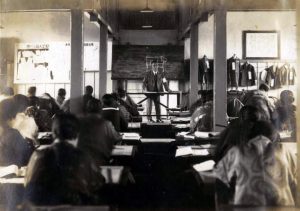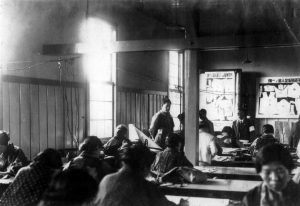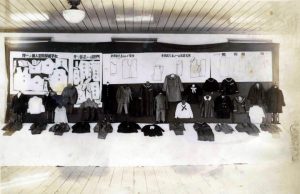Photos of clothes workshop at Army Clothing Depot in possession of two engineer A-bomb survivors vividly capture interaction between military and civilians
Apr. 26, 2024
by Minami Yamashita, Staff Writer
Three photographs remain of a workshop for teaching people how to make children’s clothes held in 1932 at the former Imperial Army Clothing Depot, A-bombed buildings in Hiroshima’s Minami Ward that were designated as national important cultural property in January. The two engineers appearing in the photos who later experienced the atomic bombing have each held on to the photos, which represent an important record that shows that era’s work styles and relationship between the military facility and the public.
One of the three photos captures the workshop in which Masaichi Tanaka, who died in 1980 at the age of 83, a clothing engineer, provided instruction at a podium from a vantage point directly in front of him. Yasuki Taba, 71, Mr. Tanaka’s grandson, who lives in the area of Kaita-cho in Hiroshima Prefecture, discovered the photo in a photo album. Mr. Tanaka is said to have traveled around Japan to teach such workshops. Another of the photos shows paper sample patterns on which is written “Examples of girl’s school clothing sample patterns” as well as rows of children’s clothes.
Mr. Tanaka is thought to have entered Hiroshima from the location where he had been evacuated several days after the atomic bombing. While working as a civil servant after the war, he continued to make his own clothes, leaving lots of khaki-colored thread at his home. Mr. Taba said, “People might have a severe image of the former Clothing Depot, which was a military organization, but I want them to know about the fact that the depot held workshops for citizens.” He provided the data of the original photos of the album to the Hiroshima Peace Memorial Museum, in the city’s Naka Ward, in 2021. His photos were introduced to the public at the museum’s new arrivals exhibit that was held through the end of February 2024.
In 2020, another original photo of the workshop was provided by Hiroshi Umitani, 93, a resident of Higashihiroshima City who is the second son of Mazumi Umitani (who died at 90 in 1986), one of the engineers. Hiroshi provided the data of the photo to a civic group that seeks to preserve the former Army Clothing Depot buildings. The photo, which also includes Mr. Tanaka, shows Mr. Umitani standing by a wall while watching over women trainees.
According to Hiroshi, Mr. Umitani continued to produce military uniforms while suffering from hearing loss. He experienced the atomic bombing in the Clothing Depot. Of his six immediate family members, his oldest son, Yoshihiro Umitani, 18 at the time, died in the bombing. Yoshihiro had been mobilized to manage the demolition of buildings for creating fire lanes at the time of the bombing as an aide at Shudo Junior High School under Japan’s former educational system. After the war ended, Mr. Umitani earned a living by making clothes at his home, located in the present-day area of Asahi in Hiroshima’s Minami Ward. He is said to have held a memorial service for his son each year on August 6.
At the time, Hiroshi was under the care of a dental clinic located in the Clothing Depot. He described his wish for the photo. “As wars persist in the world, I would like the photo to be preserved as a silent witness,” said Hiroshi.
According to Shinobu Kikuraku, director of the preservation group, the workshop seems to have been held on the second floor of the depot building in which were located the head office and a general affairs section, based on the interior structure shown in the photo. That building had been located near the entrance of the present-day Hiroshima Prefectural Hiroshima Technical High School, in Minami Ward, but was dismantled after the war. Because of the photo’s clarity, it is thought to have been taken by a professional photographer. Ms. Kikuraku said, “It was rare for photos of the interior of the clothing depot buildings to have been taken by a professional. Because Western clothes were just starting to be in vogue, the assumption is that many people were hoping to learn how to make children’s clothes.”
Keywords
Former Army Clothing Depot
The former Army Clothing Depot was a facility once used to manufacture uniforms and footwear for the former Imperial Japanese Army. The facility buildings, located 2.7 kilometers southeast of the hypocenter, were completed in 1914 and served as a temporary relief station after the atomic bombing. Following the war, the depot buildings were used as a company warehouse and a student dormitory for Hiroshima University. The depot originally consisted of 13 buildings, but now only four remain in an L-shaped configuration. The Hiroshima Prefecture government owns buildings Nos. 1–3, while building No. 4 is owned by the national government. Seismic reinforcement will be carried out for the four buildings by fiscal 2026.
(Originally published on April 26, 2024)
Three photographs remain of a workshop for teaching people how to make children’s clothes held in 1932 at the former Imperial Army Clothing Depot, A-bombed buildings in Hiroshima’s Minami Ward that were designated as national important cultural property in January. The two engineers appearing in the photos who later experienced the atomic bombing have each held on to the photos, which represent an important record that shows that era’s work styles and relationship between the military facility and the public.
One of the three photos captures the workshop in which Masaichi Tanaka, who died in 1980 at the age of 83, a clothing engineer, provided instruction at a podium from a vantage point directly in front of him. Yasuki Taba, 71, Mr. Tanaka’s grandson, who lives in the area of Kaita-cho in Hiroshima Prefecture, discovered the photo in a photo album. Mr. Tanaka is said to have traveled around Japan to teach such workshops. Another of the photos shows paper sample patterns on which is written “Examples of girl’s school clothing sample patterns” as well as rows of children’s clothes.
Mr. Tanaka is thought to have entered Hiroshima from the location where he had been evacuated several days after the atomic bombing. While working as a civil servant after the war, he continued to make his own clothes, leaving lots of khaki-colored thread at his home. Mr. Taba said, “People might have a severe image of the former Clothing Depot, which was a military organization, but I want them to know about the fact that the depot held workshops for citizens.” He provided the data of the original photos of the album to the Hiroshima Peace Memorial Museum, in the city’s Naka Ward, in 2021. His photos were introduced to the public at the museum’s new arrivals exhibit that was held through the end of February 2024.
In 2020, another original photo of the workshop was provided by Hiroshi Umitani, 93, a resident of Higashihiroshima City who is the second son of Mazumi Umitani (who died at 90 in 1986), one of the engineers. Hiroshi provided the data of the photo to a civic group that seeks to preserve the former Army Clothing Depot buildings. The photo, which also includes Mr. Tanaka, shows Mr. Umitani standing by a wall while watching over women trainees.
According to Hiroshi, Mr. Umitani continued to produce military uniforms while suffering from hearing loss. He experienced the atomic bombing in the Clothing Depot. Of his six immediate family members, his oldest son, Yoshihiro Umitani, 18 at the time, died in the bombing. Yoshihiro had been mobilized to manage the demolition of buildings for creating fire lanes at the time of the bombing as an aide at Shudo Junior High School under Japan’s former educational system. After the war ended, Mr. Umitani earned a living by making clothes at his home, located in the present-day area of Asahi in Hiroshima’s Minami Ward. He is said to have held a memorial service for his son each year on August 6.
At the time, Hiroshi was under the care of a dental clinic located in the Clothing Depot. He described his wish for the photo. “As wars persist in the world, I would like the photo to be preserved as a silent witness,” said Hiroshi.
According to Shinobu Kikuraku, director of the preservation group, the workshop seems to have been held on the second floor of the depot building in which were located the head office and a general affairs section, based on the interior structure shown in the photo. That building had been located near the entrance of the present-day Hiroshima Prefectural Hiroshima Technical High School, in Minami Ward, but was dismantled after the war. Because of the photo’s clarity, it is thought to have been taken by a professional photographer. Ms. Kikuraku said, “It was rare for photos of the interior of the clothing depot buildings to have been taken by a professional. Because Western clothes were just starting to be in vogue, the assumption is that many people were hoping to learn how to make children’s clothes.”
Keywords
Former Army Clothing Depot
The former Army Clothing Depot was a facility once used to manufacture uniforms and footwear for the former Imperial Japanese Army. The facility buildings, located 2.7 kilometers southeast of the hypocenter, were completed in 1914 and served as a temporary relief station after the atomic bombing. Following the war, the depot buildings were used as a company warehouse and a student dormitory for Hiroshima University. The depot originally consisted of 13 buildings, but now only four remain in an L-shaped configuration. The Hiroshima Prefecture government owns buildings Nos. 1–3, while building No. 4 is owned by the national government. Seismic reinforcement will be carried out for the four buildings by fiscal 2026.
(Originally published on April 26, 2024)










